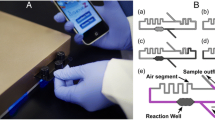Abstract
Clinical laboratories are recognizing the importance of implementing sensitive and specific molecular diagnostic tests. However, widespread adoption of these tests requires simplified workflows without requiring expensive supporting instrumentation. To enable microarray-based analysis to meet these requirements, we describe a valveless flow cell for disposable use that supports PCR coupled with microarray hybridization in the same chamber. The flow cell assembly consists simply of double-faced tape, a plastic microarray substrate, an absorbent, and a commercially-available hydrophilic thin film. The simple construction lends itself to low-cost and ease of manufacturing, yet several features reduce the complexity of the standard microarray workflow. First, there is no requirement for custom instrumentation. Second, the hydrophilic thin film allows uniform filling of a microfluidic chamber. Third, a geometric capillary stop design confines liquid to the microarray chamber during PCR, and thus eliminates the need for a valve or hydrophobic surface treatment. And fourth, imbibition drives the uniform removal of liquid reagents from the array chamber. Three hundred genomic copies of methicillin-resistant Staphylococcus aureus (MRSA) are detected in a flow cell with gel drop microarrays printed on an unmodified plastic substrate. This sensitivity is shown to be comparable to conventional methods (i.e., PCR in a tube, with separate hybridization in a microarray chamber, where amplicon is exposed to the workspace before and after hybridization). However, the flow cell combines these multiple steps into a simple, compact workflow without the need for complex valves or custom instrumentation and is less susceptible to contamination of the workspace than conventional methods because the amplicon is confined to the device.






Similar content being viewed by others
References
M. Burns, B. Johnson, S. Brahmasandra, K. Handique, Science 282, 484 (1998)
A. Castley, M. Higgins, J. Ivey, C. Mamotte, D.C. Sayer, F.T. Christiansen, Clin. Chem. 51, 2025 (2005)
Z. Chen, J. Wang, S. Qian, H.H. Bau, Lab. Chip 5, 1277 (2005)
M. Dong, I. Chatzis, J. Colloid Interface Sci. 172, 278 (1995)
Y. Feng, Z. Zhou, X. Ye, J. Xiong, Sens. Actuators A 138, 108 (2003)
A.K. Henning, Aerospace Conference. Proc. IEEE, Colorado, 471 (1998)
M. Kohl, D. Dittmann, E. Quandt, B. Winzek, Sens. Actuators A 83, 214 (2000)
T.P. Liao, P. Chung, JISE 17, 713 (2001)
Y. Liu, C.B. Rauch, R.L. Stevens, R. Lenigk, J. Yang, D.B. Rhine et al., Anal. Chem. 74, 3063 (2002)
R.H. Liu, J. Yang, R. Lenigk, J. Bonanno, P. Grodzinski, Anal. Chem. 76, 1824 (2004)
M. Madou, L. Lee, S. Daunert, S. Lai, C. Shih, Biomed. Microdevices 3, 245 (2001)
D. Mark, T. Metz, S. Haeberle, S. Lutz, J. Ducr, R. Zengerleab, F. von Stettenab, Lab. Chip 9, 3599 (2009)
R. Pal, M. Yang, B.N. Johnson, D.T. Burke, M.A. Burns, Anal. Chem. 76, 3740 (2004)
C.M. Pemble, B.C. Towe, Sens. Actuators A 77, 145 (1999)
A.C. Richards Grayson, R.S. Shawgo, A.M. Johnson, N.T. Flynn, Y. Li, M.J. Cima, R. Langer, Proc. IEEE, 92 (2004)
A. Rubina, E.I. Dementieva, A.A. Stomakhin, E.L. Darii, S.V. Pan’kov, V.E. Barsky, S.M. Ivanov, E.V. Konovalova, A.D. Mirzabekov, Biotechniques 34, 1008 (2003)
A. Saeed et al., Biotechniques 34, 374 (2003)
E. Schäffer, P. Wong, Phys. Rev. Lett. 80, 3069 (1998)
A.E. Sgro, P.B. Allen, D.T. Chiu, Anal. Chem. 79, 4845 (2007)
T. Thorsen, S.J. Maerkl, S.R. Quake, Science 298, 580 (2002)
TIFF Revision 6.0. (1992)
A.V. Vasiliskov, E.N. Timofeev, S.A. Surzhikov, A.L. Drobyshev, V.V. Shick, A.D. Mirzabekov, Biotechniques 27, 592 (1999)
J. Wang, Z.Y. Chen, M. Mauk, K.S. Hong, M.Y. Li, S. Yang et al., Biomed. Microdevices 7, 313 (2005)
M. Weislogel, S. Lichter, J. Fluid Mech. 373, 349 (1998)
R.N. Wenzel, Ind. Eng. Chem. 28, 988 (1938)
X. Yang, C. Grosjean, Y.-C. Tai, C.-M. Ho, Proc. IEEE (MEMS ‘97), Japan, 114 (1997)
C. Zhang, D. Xing, Nucleic Acids Res. 35, 4223 (2007)
Acknowledgements
The authors wish to thank partial support from the National Institutes of Health (grant no. 1 RO1 AI59517). Some of the development of the flow cell design was supported by Award No. 2007-DN-BX-K145, awarded by the National Institute of Justice, Office of Justice Programs, U.S. Department of Justice. The opinions, findings, and conclusions or recommendations expressed in this publication are those of the authors and do not necessarily reflect those of the Department of Justice. The authors also wish to acknowledge the helpful insights gained from attendance at Math-in-Industry Workshop, Claremont Colleges 2009.
Author information
Authors and Affiliations
Corresponding author
Rights and permissions
About this article
Cite this article
Cooney, C.G., Sipes, D., Thakore, N. et al. A plastic, disposable microfluidic flow cell for coupled on-chip PCR and microarray detection of infectious agents. Biomed Microdevices 14, 45–53 (2012). https://doi.org/10.1007/s10544-011-9584-9
Published:
Issue Date:
DOI: https://doi.org/10.1007/s10544-011-9584-9




